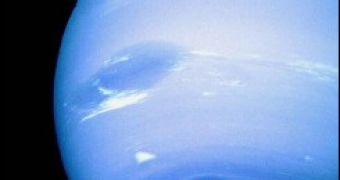The configuration of the solar system as observed today poses some serious questions about how the planets might have evolved from the protoplanetary disk spinning around the Sun, as current models cannot yet explain how a planet the size of Jupiter could have formed in only a few million years, while predictions regarding Neptune and Uranus suggest that they might have needed more than a billion years to evolve into gas giants.
Our Sun and the planets orbiting it formed from a so-called solar nebula, a large cloud of dust and gas that collapsed under the influence of the gravitational field it generated. As more and more matter was drawn towards the object forming in the center of the nebula, it quickly evolved into a star and the remnant material was compacted into a thin protoplanetary disk spinning around it, which eventually spawned planets.
However, calculations on the density of the solar nebula from which the solar system formed and that of the protoplanetary disk, critical when determining how long it took for the planets to form and what type of chemical elements they contain, reveal that they do not match the measurement made on the composition of the Sun.
Most of the research done in this area for the last 30 years involved the estimation of the density of the minimum mass nebula necessary to create the solar system. The basic principle behind the measurement consists in analyzing the heavy components of every planet, and adding extra quantities of hydrogen and helium gas, until the composition closely resembled that observed in the Sun. However, though this method approximates the observed configuration of the solar system, it has certain flaws in its design as it suggests that the matter in the protoplanetary disk would be too scattered to allow the planet formation process.
An alternative model for the formation of the solar system could be provided by the Nice model that explains part of the planetary formation of the gas giants, as well as the small objects observed in the Kuiper Belt and the comets that have orbits that take them in the outermost regions of the solar system, by postulating that Jupiter and the other large planets beyond its orbit actually formed much closer together than they currently are.
Computer simulations suggest for example that Neptune might have formed at a distance of less than half its current orbit and could have possibly switched places with the planet Uranus. By doing so, the density of the protoplanetary disk would present smaller variations. However, this implies that opposing the previous available theory, the density of the nebula would have been much greater, enabling the planets to form faster. Furthermore, the model suggests that the remnant material that creates the protoplanetary disk is cleaned up rather fast in most of the forming solar systems and can't exist for more that 10 million years.
The Nice model explaining the forming of the solar system also revealed that the density of the protoplanetary disk can be greatly affected by the influence of the so-called photoevaporation process, through ultraviolet radiation emitted by the close massive stars, pushing matter to the outer regions of the solar system.

 14 DAY TRIAL //
14 DAY TRIAL //